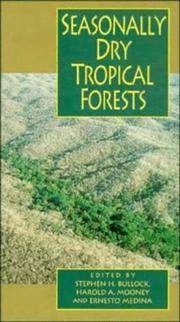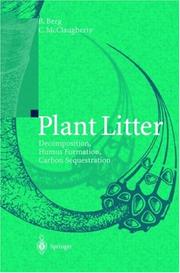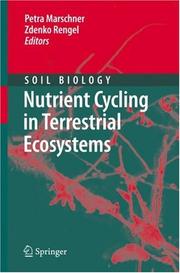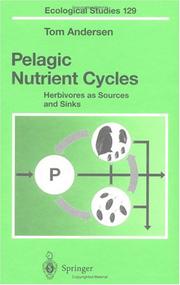| Listing 1 - 10 of 22 | << page >> |
Sort by
|
Book

Year: 2020 Publisher: Frontiers Media SA
Abstract | Keywords | Export | Availability | Bookmark
 Loading...
Loading...Choose an application
- Reference Manager
- EndNote
- RefWorks (Direct export to RefWorks)
This eBook is a collection of articles from a Frontiers Research Topic. Frontiers Research Topics are very popular trademarks of the Frontiers Journals Series: they are collections of at least ten articles, all centered on a particular subject. With their unique mix of varied contributions from Original Research to Review Articles, Frontiers Research Topics unify the most influential researchers, the latest key findings and historical advances in a hot research area! Find out more on how to host your own Frontiers Research Topic or contribute to one as an author by contacting the Frontiers Editorial Office: frontiersin.org/about/contact
fluid dynamics --- ecosystem engineering --- coral --- algae --- canopy --- mass transport --- light availability --- nutrient cycling
Book

Year: 2020 Publisher: Frontiers Media SA
Abstract | Keywords | Export | Availability | Bookmark
 Loading...
Loading...Choose an application
- Reference Manager
- EndNote
- RefWorks (Direct export to RefWorks)
This eBook is a collection of articles from a Frontiers Research Topic. Frontiers Research Topics are very popular trademarks of the Frontiers Journals Series: they are collections of at least ten articles, all centered on a particular subject. With their unique mix of varied contributions from Original Research to Review Articles, Frontiers Research Topics unify the most influential researchers, the latest key findings and historical advances in a hot research area! Find out more on how to host your own Frontiers Research Topic or contribute to one as an author by contacting the Frontiers Editorial Office: frontiersin.org/about/contact
Science: general issues --- Oceanography (seas) --- fluid dynamics --- ecosystem engineering --- coral --- algae --- canopy --- mass transport --- light availability --- nutrient cycling --- fluid dynamics --- ecosystem engineering --- coral --- algae --- canopy --- mass transport --- light availability --- nutrient cycling
Book

Year: 2020 Publisher: Frontiers Media SA
Abstract | Keywords | Export | Availability | Bookmark
 Loading...
Loading...Choose an application
- Reference Manager
- EndNote
- RefWorks (Direct export to RefWorks)
This eBook is a collection of articles from a Frontiers Research Topic. Frontiers Research Topics are very popular trademarks of the Frontiers Journals Series: they are collections of at least ten articles, all centered on a particular subject. With their unique mix of varied contributions from Original Research to Review Articles, Frontiers Research Topics unify the most influential researchers, the latest key findings and historical advances in a hot research area! Find out more on how to host your own Frontiers Research Topic or contribute to one as an author by contacting the Frontiers Editorial Office: frontiersin.org/about/contact
Science: general issues --- Oceanography (seas) --- fluid dynamics --- ecosystem engineering --- coral --- algae --- canopy --- mass transport --- light availability --- nutrient cycling
Book
ISBN: 047190449X Year: 1985 Publisher: Chichester John Wiley & Sons
Abstract | Keywords | Export | Availability | Bookmark
 Loading...
Loading...Choose an application
- Reference Manager
- EndNote
- RefWorks (Direct export to RefWorks)
Nature protection --- Plant ecology. Plant sociology --- Forestry --- Subtropical and Tropical Countries --- Biogeochemical cycles --- Forest ecology --- Forest management --- Forest conservation --- Cycles biogéochimiques --- Ecologie forestière --- Forêts --- Tropics --- Régions tropicales --- Gestion --- Conservation --- Nutrient cycles --- Cycles biogéochimiques --- Ecologie forestière --- Forêts --- Régions tropicales --- Nutrient cycling --- Food chains (Ecology)
Book
ISBN: 2550348281 9782550348283 Year: 1999 Volume: 134 Publisher: Sainte-Foy: Gouvernement du Québec. Ministère des ressources naturelles. Forêt Québec. Direction de la recherche forestière,
Abstract | Keywords | Export | Availability | Bookmark
 Loading...
Loading...Choose an application
- Reference Manager
- EndNote
- RefWorks (Direct export to RefWorks)
Cycle des elements mineraux (Biogeochimie) --- Ecologie du couvert forestier --- Feuilles --- Resorption (Physiologie) --- Erable a sucre --- Physiologie --- Acer saccharum --- Canada --- forestry --- nutrient cycling --- Cycle des elements mineraux (Biogeochimie) - Quebec (Province) - Clair, Bassin du lac (La Jacques-Cartier) --- Ecologie du couvert forestier - Quebec (Province) - Clair, Bassin du lac (La Jacques-Cartier) --- Feuilles - Physiologie --- Erable a sucre - Quebec (Province) - Clair, Bassin du lac (La Jacques-Cartier)
Book
ISBN: 9813236035 9813236027 Year: 2018 Publisher: World Scientific Publishing Co.
Abstract | Keywords | Export | Availability | Bookmark
 Loading...
Loading...Choose an application
- Reference Manager
- EndNote
- RefWorks (Direct export to RefWorks)
Neighbourhood landscapes are the quintessential forms of urban landscapes in most cities worldwide. They are pervasive, and hence experienced by the large majority of urban dwellers in their everyday life. More than parks, nature reserves or nature areas which are visited as destinations, neighbourhood landscapes provide the most immediate, frequent and convenient form of nature experienced by urban dwellers on a daily basis. They are also valuable as social spaces to bring residents together, foster social ties, and strengthen communities. Despite their importance, surprisingly little has been written to guide the planning and design of neighbourhood landscapes. This book is written for a specific purpose, to illustrate how the design of neighbourhood landscapes helps to deliver more benefits for urban dwellers and, at the same time, protect ecosystems that facilitate human well-being. This is in turn important as the synergistic relationships between human well-being, quality of biophysical urban environment, and health of human–environment interactions fundamentally underpin urban sustainability. The authors emphasize the role neighbourhood landscapes play in forging connections between people and nature, people and people, and people and place. Most of all, the book highlights the role of focusing on people in this endeavour, as it is only when landscapes are appropriately designed, and when people recognize these benefits, that they become valued and protected as a community resource. This book is organized into two parts. Part 1 focuses on the conceptual foundations that underpin the neighbourhood landscape design guidelines being developed. In this section, the authors describe the key concepts relating functions of neighbourhood landscapes to the key urban development goals of sustainability, liveability and reliance; how they can be represented in a framework; and how a synthesis of current knowledge of cities as socio-ecological systems helps to identify principles that can guide the designing of neighbourhood landscapes. Part 2 is more application focused, and is centred on neighbourhood landscape design guidelines inspired by the concept of ecosystem services. The guidelines consist of design approaches, practical strategies, design targets and performance monitoring indicators for tracking the performance of neighbourhood landscapes. The book is written for readers in academia and design practice, and anyone who has a role in shaping neighbourhood landscapes for the benefit of urban dwellers.
Urban Landscapes --- Irrigation --- Urban Areas --- Neighbourhoods --- Environmental Education --- Aesthetic Values --- Living Spaces --- Biodiversity --- Heat Mitigation --- Noise Abatement --- Landscape Design --- Nature --- Soil Quality Maintenance --- Social Relations --- Storm and Domestic Waste Water Treatment --- Flood Hazard Mitigation --- People --- Neighbourhood Landscape --- Water Cycling --- Ecology --- Nutrient Cycling --- Landscape Development --- Green Spaces --- Landscape Services --- Erosion Control --- Recreational Spaces --- Open Spaces --- Sense of Place --- Recreation --- Typology --- Parks

ISBN: 0521435145 Year: 1995 Publisher: Cambridge : Cambridge University Press,
Abstract | Keywords | Export | Availability | Bookmark
 Loading...
Loading...Choose an application
- Reference Manager
- EndNote
- RefWorks (Direct export to RefWorks)
Forêt saisonnière tropicale --- Tropical seasonal forests --- Savane --- Savannas --- Steppe forestière --- Forest steppe --- Composition botanique --- Botanical composition --- Ressource végétale --- Plant resources --- Ressource animale --- Animal resources --- Changement climatique --- Climatic change --- Régénération naturelle --- Natural regeneration --- Biologie forestière --- Forestry biology --- Écologie forestière --- forest ecology --- Amérique centrale --- Central America --- Caraïbes --- Caribbean --- Brazil --- Afrique --- Africa --- ECO Ecology --- America --- Asia --- biomass --- diversity --- ecology --- ethnobotany --- fauna --- floristics --- higher plants --- life forms --- nutrient cycling --- plant-herbivore relationships --- productivity --- reproduction --- savannas --- seasonnally dry tropical forests --- soil --- woodlands

ISBN: 3540443290 3662053519 3662053497 9783540443292 Year: 2003 Publisher: Berlin: Springer,
Abstract | Keywords | Export | Availability | Bookmark
 Loading...
Loading...Choose an application
- Reference Manager
- EndNote
- RefWorks (Direct export to RefWorks)
The present book gives a modernized and comprehensive overview of the degradation of major litter components as well as the sum of processes when forest plant litter decomposes, releases nutrients and turns into humus. Covering mainly boreal and temperate forests, the book gives a synthesis of the different sub-processes on the basis that decomposition is microbially mediated and develops a system in the decomposition processes leading to chemical changes in litter. Further, it introduces a conceptual model for litter transformations from litter fall until the decomposing litter accumulates as humus. The effects of substrate quality, climate, and their interactions on decomposition are presented as well as examples of litter types that break the basic pattern. A system is suggested for humus accumulation rates among forest systems, a system that may be a starting point for estimates of carbon sequestration in forest systems.
ECO Ecology --- carbon --- decomposition --- ecology --- forests --- humus --- litter --- nutrient cycling --- saprophytic Fungi --- soil ecology --- Ecology . --- Geoecology. --- Environmental geology. --- Nature conservation. --- Plant science. --- Botany. --- Microbiology. --- Ecology. --- Geoecology/Natural Processes. --- Nature Conservation. --- Plant Sciences. --- Microbial biology --- Biology --- Microorganisms --- Botanical science --- Phytobiology --- Phytography --- Phytology --- Plant biology --- Plant science --- Natural history --- Plants --- Conservation of nature --- Nature --- Nature protection --- Protection of nature --- Conservation of natural resources --- Applied ecology --- Conservation biology --- Endangered ecosystems --- Natural areas --- Geoecology --- Environmental protection --- Physical geology --- Balance of nature --- Bionomics --- Ecological processes --- Ecological science --- Ecological sciences --- Environment --- Environmental biology --- Oecology --- Environmental sciences --- Population biology --- Conservation --- Ecology --- Floristic botany --- Plant litter --- Soil ecology --- Biodegradation --- Plant litter - Biodegradation

ISBN: 1280853778 9786610853779 3540680276 3540680268 3642087663 Year: 2007 Publisher: Berlin ; New York : Springer,
Abstract | Keywords | Export | Availability | Bookmark
 Loading...
Loading...Choose an application
- Reference Manager
- EndNote
- RefWorks (Direct export to RefWorks)
Nutrient Cycling in Terrestrial Ecosystems presents a comprehensive overview of nutrient cycling processes and their importance for plant growth and ecosystem sustainability. The first part of the book presents the fundamentals of nutrient cycling. Topics included are cycling of carbon, nitrogen, phosphorus, sulphur and micronutrients. Particular attention is paid to the role of root exudates and rhizosphere microorganisms in facilitating nutrient cycling. The second part discusses nutrient cycling at an ecosystem scale, covering cropping systems, pastures, natural grasslands, arid lands, tundras and forests. The final chapter reviews current models of nutrient cycling. By comprehensively covering nutrient cycling at a range of scales and emphasising multidisciplinary approaches, this volume will support scientists and practitioners alike, providing links between those involved in improving sustainable economic output from managed ecosystems and those interested in conservation of natural ecosystems.
Nutrient cycles. --- Growth (Plants) --- Ecology. --- Conservation of natural resources. --- Balance of nature --- Biology --- Bionomics --- Ecological processes --- Ecological science --- Ecological sciences --- Environment --- Environmental biology --- Oecology --- Environmental sciences --- Population biology --- Ecology --- Conservation of resources --- Natural resources --- Natural resources conservation --- Resources conservation, Natural --- Environmental protection --- Natural resources conservation areas --- Plant growth --- Plants --- Growth --- Plant physiology --- Meristems --- Plant growth-promoting rhizobacteria --- Rejuvenescence (Botany) --- Nutrient cycling --- Biogeochemical cycles --- Food chains (Ecology) --- Conservation --- Development --- Endangered ecosystems. --- Biochemistry. --- Agriculture. --- Environmental Science and Engineering. --- Terrestial Ecology. --- Ecosystems. --- Plant Biochemistry. --- Geoecology/Natural Processes. --- Farming --- Husbandry --- Industrial arts --- Life sciences --- Food supply --- Land use, Rural --- Threatened ecosystems --- Biotic communities --- Nature conservation --- Biological chemistry --- Chemical composition of organisms --- Organisms --- Physiological chemistry --- Chemistry --- Medical sciences --- Composition --- Environmental sciences. --- Ecology . --- Plant biochemistry. --- Geoecology. --- Environmental geology. --- Geoecology --- Physical geology --- Phytochemistry --- Plant biochemistry --- Plant chemistry --- Biochemistry --- Botany --- Phytochemicals --- Plant biochemical genetics --- Biocenoses --- Biocoenoses --- Biogeoecology --- Biological communities --- Biomes --- Biotic community ecology --- Communities, Biotic --- Community ecology, Biotic --- Ecological communities --- Ecosystems --- Natural communities --- Environmental science --- Science

ISBN: 3540618813 3642082793 3662034182 9783540618812 Year: 1997 Volume: 129 Publisher: Berlin : Springer,
Abstract | Keywords | Export | Availability | Bookmark
 Loading...
Loading...Choose an application
- Reference Manager
- EndNote
- RefWorks (Direct export to RefWorks)
While ecology is one of the scientific disiplines that most clearly belongs to ''basic research", it also strives to serve as a predictive tool for management. Outstanding examples of predictive ecology are Vollenweider's models on the relationship between phosphorus load and water renewal time of lakes, and the resulting algal biomass. The needed few and easily accessible input parameters to very simple models provided a direct link from basic ecology to management, and today these models are key tools for managers worldwide to control lake eutrophication and algal blooms. The baseline of this success is the general relation between phosphorus concentration and phytoplankton biomass that is observed for most lakes. While these relationships are most frequently presented in log-log diagrams, the aquatic ecologist who replots these a linear scale may ask himself why, in spite of the overall correlation, there is still such a variability. It is possible to predict levels of algal biomass that may be synthesized at a given phosphorus load. Some lakes apparently offer optimal conditions for their phytoplankton communities, while others may support less than half the biomass at the same phosphorus load. There are limits to growth, however, and the predic tive outcome of phosphorus load decreases as the load increases. This holds in particular for the higher trophic levels like zooplankton and fish. With increased enrichment there are signs of decreased efficiency of energy trans fer between foodweb compartments.
Herbivores --- Nutrient cycles --- Food chains (Ecology) --- Food --- Issue --- Ecology . --- Life sciences. --- Agriculture. --- Geoecology. --- Environmental geology. --- Nature conservation. --- Oceanography. --- Ecology. --- Life Sciences, general. --- Geoecology/Natural Processes. --- Nature Conservation. --- Oceanography, Physical --- Oceanology --- Physical oceanography --- Thalassography --- Earth sciences --- Marine sciences --- Ocean --- Conservation of nature --- Nature --- Nature protection --- Protection of nature --- Conservation of natural resources --- Applied ecology --- Conservation biology --- Endangered ecosystems --- Natural areas --- Geoecology --- Environmental protection --- Physical geology --- Farming --- Husbandry --- Industrial arts --- Life sciences --- Food supply --- Land use, Rural --- Biosciences --- Sciences, Life --- Science --- Balance of nature --- Biology --- Bionomics --- Ecological processes --- Ecological science --- Ecological sciences --- Environment --- Environmental biology --- Oecology --- Environmental sciences --- Population biology --- Conservation --- Ecology --- Nutrient cycles. --- Food webs (Ecology) --- Trophic ecology --- Animals --- Nutrient cycling --- Biogeochemical cycles --- Herbivores - Food --- CYCLING --- LAKES --- NUTRIENTS --- ALGAE --- HERBIVORES --- FOOD CHAINS --- EUTROPHICATION --- BIOGEOCHEMICAL CYCLES --- DYNAMIC MODELS
| Listing 1 - 10 of 22 | << page >> |
Sort by
|

 Search
Search Feedback
Feedback About UniCat
About UniCat  Help
Help News
News